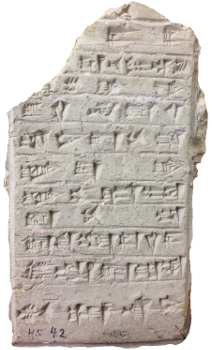Inscriptions
Only a handful of inscriptions are known for Ashurbanipal's son and immediate successor Aššur-etel-ilāni; more texts of his are attested from Babylonia than from Assyria. The inscriptions are found on bricks, a clay cylinders, and clay tablets. All but one is written in the Standard Babylonian dialect of Akkadian; a brick inscription discovered at Nippur is composed in Sumerian. Several of the inscriptions provide details about his building activities and support of temples, and one text records that he had the remains of an earlier Chaldean ruler returned from Assyria to its proper place in Bīt-Dakkūri. Aššur-etel-ilāni is known to have sponsored building on or donated inscribed objects to the temples E-ibbi-Anum (Dilbat), Esagil (Babylon), Ekur (Nippur), and Eešerke (Sippar-Aruru).
Ashur-etel-ilāni 1 Ashur-etel-ilāni 2 Ashur-etel-ilāni 3 Ashur-etel-ilāni 4 Ashur-etel-ilāni 5
A clay tablet bearing a copy of an Akkadian inscription of Aššur-etel-ilāni records that this Assyrian king had an offering table made of musukkannu-wood and ṣāriru-gold for the god Marduk. A two-line note appears after the inscription and it mentions food offerings that were to be presented to Babylon's tutelary deity, the name of an individual (Nādin, son of Bēl-aḫḫē-iqīša), and a date (the eleventh day of the month Elūlu [VI] of the king's third regnal year).
Access the composite text [http://oracc.museum.upenn.edu/ribo/babylon6/Q003857] of Aššur-etel-ilāni Babylonian 1.
Source
Bibliography
- Leichty 1983 [http://oracc.museum.upenn.edu/ribo/babylon6/bibliography/index.html#leichty1983], pp. 217-220 (edition)
- Frame 1995 [http://oracc.museum.upenn.edu/ribo/babylon6/bibliography/index.html#frame1995], pp. 262-263 B.6.35.1 (edition)
- Leichty 1983 [http://oracc.museum.upenn.edu/ribo/babylon6/bibliography/index.html#leichty1983], p. 218 (photo)
- Brinkman and Kennedy 1986 [http://oracc.museum.upenn.edu/ribo/babylon6/bibliography/index.html#brinkmanandkennedy1986], p. 103 no. Mn.2 (study)
A clay tablet discovered at Babylon in 1911 is inscribed with an Akkadian text stating that Aššur-etel-ilāni had a gold scepter commission for the god Marduk and had it placed in that god's shrine at Sippar-Aruru (Eešerke; "House, Shrine of Weeping").
Access the composite text [http://oracc.museum.upenn.edu/ribo/babylon6/Q003858] of Aššur-etel-ilāni Babylonian 2.
Source
Bibliography
- Ebeling 1935 [http://oracc.museum.upenn.edu/ribo/babylon6/bibliography/index.html#ebeling1935], pp. 71-73 (edition)
- Frame 1995 [http://oracc.museum.upenn.edu/ribo/babylon6/bibliography/index.html#frame1995], pp. 263-264 B.6.35.2 (edition)
- Marzahn and Frame 1996 [http://oracc.museum.upenn.edu/ribo/babylon6/bibliography/index.html#marzahnandframe1996], p. 96 (copy)
- Marzahn and Frame 1996 [http://oracc.museum.upenn.edu/ribo/babylon6/bibliography/index.html#marzahnandframe1996], p. 95 (study)
A brick in the Weld-Blundell Collection of the Ashmolean Museum (Oxford) is inscribed with an Akkadian inscription of this successor of Ashurbanipal. The six-line text records Aššur-etel-ilāni's restoration of the temple of the god Uraš and the goddess Ninegal at Dilbat, whose Akkadian ceremonial name was E-ibbi-Anum ("House the God Anu Named"). In addition, the inscription states that the Assyrian king had a well of that temple cleared of debris.
Access the composite text [http://oracc.museum.upenn.edu/ribo/babylon6/Q003859] of Aššur-etel-ilāni Babylonian 3.
Source
Bibliography
- Langdon 1923 [http://oracc.museum.upenn.edu/ribo/babylon6/bibliography/index.html#langdon1923], pp. 37–38 (edition)
- Luckenbill 1927 [http://oracc.museum.upenn.edu/ribo/babylon6/bibliography/index.html#luckenbill1927], §1135A (translation)
- Walker 1981 [http://oracc.museum.upenn.edu/ribo/babylon6/bibliography/index.html#walker1981], no. 87 (transliteration)
- Frame 1995 [http://oracc.museum.upenn.edu/ribo/babylon6/bibliography/index.html#frame1995], pp. 264-265 B.6.35.3 (edition)
- Langdon 1923 [http://oracc.museum.upenn.edu/ribo/babylon6/bibliography/index.html#langdon1923], pl. 29 (copy)
- Borger 1957 [http://oracc.museum.upenn.edu/ribo/babylon6/bibliography/index.html#borger1957], p. 7 (study to line 3)
A fragment of a brick discovered at Nippur (now in the Hilprecht collection of the Friedrich-Schiller-Universität [Jena]) is inscribed (not stamped) with a thirteen line Sumerian inscription of Aššur-etel-ilāni stating that this Assyrian king rebuild (part of) Enlil's temple Ekur ("House, Mountain").

A brick of Aššur-etel-ilāni discovered at Nippur and now in the Hilprecht collection of the Friedrich-Schiller-Universität (Jena). Photograph taken by Karen Radner.
Access the composite text [http://oracc.museum.upenn.edu/ribo/babylon6/Q003860] of Aššur-etel-ilāni Babylonian 4.
Source
Bibliography
- Edzard 1959-1960 [http://oracc.museum.upenn.edu/ribo/babylon6/bibliography/index.html#edzard1959-1960], p. 143 (edition)
- Edzard 1959-1960 [http://oracc.museum.upenn.edu/ribo/babylon6/bibliography/index.html#edzard1959-1960], p. 143 (photo)
- Oelsner 1969 [http://oracc.museum.upenn.edu/ribo/babylon6/bibliography/index.html#oelsner1969], p. 54 no. 33 (study)
A clay tablet and two small clay cylinders are inscribed with an Akkadian inscription of Aššur-etel-ilāni recording that he had the remains of a seventh-century Bīt-Dakkūri returned from Assyria to its ancestral home Dūru-ša-Ladīni ("Fortress of Ladīnu"); the tribal leader in question, Šamaš-ibni, was likely the Dakkurian leader whom Esarhaddon had taken to Assyria and executed in 678 BC. This act on the part of Aššur-etel-ilāni presumably reflects his attempt to win the support of this important Chaldean tribe.
Access the composite text [http://oracc.museum.upenn.edu/ribo/babylon6/Q003861] of Aššur-etel-ilāni Babylonian 5.
Sources
| (1) YBC 02151 | (2) NBC 06069 |
| (3) NBC 06070 |
Bibliography
- Clay 1915 [http://oracc.museum.upenn.edu/ribo/babylon6/bibliography/index.html#clay1915], no. 43 (ex. 1, edition)
- Meissner 1918 [http://oracc.museum.upenn.edu/ribo/babylon6/bibliography/index.html#meissner1918], 223 (ex. 1, partial translation)
- Luckenbill 1927 [http://oracc.museum.upenn.edu/ribo/babylon6/bibliography/index.html#luckenbill1927], §§1132–1135 (ex. 1, translation)
- Bottéro in Gnoli and Vernant 1982 [http://oracc.museum.upenn.edu/ribo/babylon6/bibliography/index.html#gnoliandvernant1982], pp. 383–386 no. 6 and p. 403 (exs. 1–3, edition)
- Hecker 1988 [http://oracc.museum.upenn.edu/ribo/babylon6/bibliography/index.html#hecker1988], p. 478 (exs. 1–3, translation)
- Frame 1995 [http://oracc.museum.upenn.edu/ribo/babylon6/bibliography/index.html#frame1995], pp. 266-268 B.6.35.5 (edition)
- Clay 1915 [http://oracc.museum.upenn.edu/ribo/babylon6/bibliography/index.html#clay1915], no. 43 (ex. 1, copy)
- Stephens 1937 [http://oracc.museum.upenn.edu/ribo/babylon6/bibliography/index.html#stephens1937], no. 81 (ex. 2, copy) and no. 82 (ex. 3, copy)
- Ungnad 1922 [http://oracc.museum.upenn.edu/ribo/babylon6/bibliography/index.html#ungnad1922a], 3 (ex. 1, study)
Jamie Novotny
Jamie Novotny, 'Inscriptions', RIBo, Babylon 6: The Inscriptions of the Period of the Uncertain Dynasties, The RIBo Project, a sub-project of MOCCI, 2017 [http://oracc.museum.upenn.edu/ribo/babylon6/periodofassyriandomination/ashuretelilani/inscriptions/]